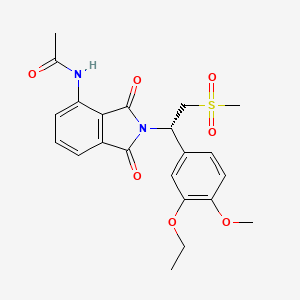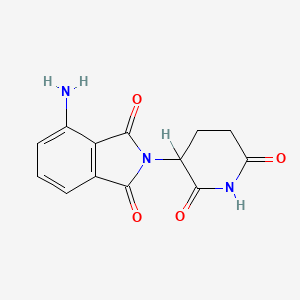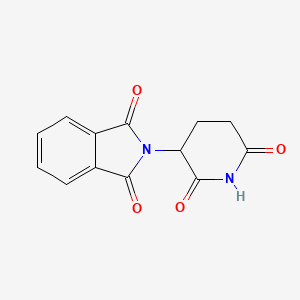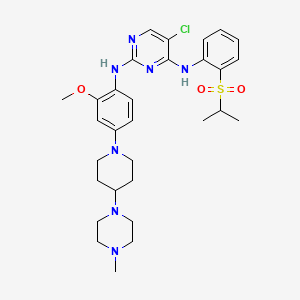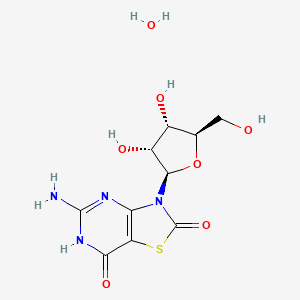
Nifurtimox
Overview
Description
Nifurtimox is a nitrofuran derivative used primarily as an antiparasitic medication. It is marketed under the brand name Lampit and is used to treat Chagas disease (American trypanosomiasis) and African trypanosomiasis (sleeping sickness) . This compound was developed by Bayer and has been in use since 1965 . It is included in the World Health Organization’s List of Essential Medicines .
Mechanism of Action
Target of Action
Nifurtimox primarily targets the parasite Trypanosoma cruzi , which causes Chagas disease . The drug exerts its trypanosomal activity against this parasite .
Mode of Action
It is believed to occur through the activation of nitroreductase enzymes that produce reactive metabolites . These metabolites have a series of deleterious effects on Trypanosoma cruzi . Nitro reductase activity results in the formation of nitro anion radicals, causing the formation of oxygen radicals that result in decreased protein and nucleic acid synthesis, breakage of DNA, and inhibition of parasite growth .
Biochemical Pathways
This compound and other benzofuran derivatives are known to reduce parasite dehydrogenase activity . This action affects the biochemical pathways of the parasite, leading to its death .
Pharmacokinetics
This compound exhibits low bioavailability . It is metabolized in the liver, with cytochrome P450 oxidase (CYP) involved in the process . The elimination half-life of this compound is approximately 2.95 ± 1.19 hours . Excretion is primarily through the kidneys, although the rate of renal excretion is very low . The pharmacokinetic analysis suggests that the low serum concentration of this compound is probably the result of a marked first-pass effect .
Result of Action
The result of this compound’s action is the reduction of the Trypanosoma cruzi population in the host. A significant number of patients with acute or chronic Chagas disease treated with this compound were found to be immunoglobulin G (IgG) antibody negative and demonstrated at least a 20% decrease in optical density on two IgG antibody tests for T. cruzi antigens .
Preparation Methods
Synthetic Routes and Reaction Conditions
Nifurtimox is synthesized through a multi-step process involving the reaction of 5-nitro-2-furaldehyde with 3-methyl-4-thiomorpholine-1,1-dioxide . The reaction conditions typically involve the use of solvents such as ethanol and catalysts to facilitate the formation of the final product .
Industrial Production Methods
Industrial production of this compound involves large-scale synthesis using similar reaction conditions as in the laboratory synthesis. The process is optimized for yield and purity, with stringent quality control measures to ensure the consistency of the final product .
Chemical Reactions Analysis
Types of Reactions
Nifurtimox undergoes several types of chemical reactions, including:
Oxidation: The nitro group in this compound can be reduced to form nitro anion radicals.
Reduction: The nitro group can also undergo reduction to form amines.
Substitution: This compound can participate in nucleophilic substitution reactions.
Common Reagents and Conditions
Common reagents used in the reactions of this compound include reducing agents such as sodium borohydride and oxidizing agents like hydrogen peroxide . The reactions are typically carried out under controlled temperature and pH conditions to ensure the desired product formation .
Major Products Formed
The major products formed from the reactions of this compound include reduced amines and substituted derivatives, depending on the specific reaction conditions and reagents used .
Scientific Research Applications
Nifurtimox has a wide range of scientific research applications, including:
Chemistry: Used as a model compound to study nitrofuran derivatives and their reactivity.
Biology: Investigated for its effects on cellular processes and its potential as an antiparasitic agent.
Medicine: Used in the treatment of Chagas disease and sleeping sickness.
Industry: Employed in the development of new antiparasitic drugs and formulations.
Comparison with Similar Compounds
Similar Compounds
Benznidazole: Another nitrofuran derivative used to treat Chagas disease.
Pentamidine: Used to treat African trypanosomiasis and other parasitic infections.
Uniqueness of Nifurtimox
This compound is unique in its ability to generate reactive oxygen species through redox cycling, which contributes to its antiparasitic activity . It is also notable for its inclusion in combination therapies, such as the this compound-eflornithine combination treatment for sleeping sickness .
Properties
| The mechanism of action of nifurtimox has not been fully elucidated, however, is believed to occur by the activation of nitroreductase enzymes that produce reactive metabolites with a series of deleterious effects on Trypanosoma cruzi, the parasite causing Chagas disease. The antiprotozoal actions of nifurtimox occur both intracellularly and extracellularly. Inhibition of parasite dehydrogenase activity is another purported mode of action of nifurtimox that warrants further research. | |
CAS No. |
23256-30-6 |
Molecular Formula |
C10H13N3O5S |
Molecular Weight |
287.29 g/mol |
IUPAC Name |
(Z)-N-(3-methyl-1,1-dioxo-1,4-thiazinan-4-yl)-1-(5-nitrofuran-2-yl)methanimine |
InChI |
InChI=1S/C10H13N3O5S/c1-8-7-19(16,17)5-4-12(8)11-6-9-2-3-10(18-9)13(14)15/h2-3,6,8H,4-5,7H2,1H3/b11-6- |
InChI Key |
ARFHIAQFJWUCFH-WDZFZDKYSA-N |
SMILES |
CC1CS(=O)(=O)CCN1N=CC2=CC=C(O2)[N+](=O)[O-] |
Isomeric SMILES |
CC1CS(=O)(=O)CCN1/N=C\C2=CC=C(O2)[N+](=O)[O-] |
Canonical SMILES |
CC1CS(=O)(=O)CCN1N=CC2=CC=C(O2)[N+](=O)[O-] |
Appearance |
Solid powder |
boiling_point |
550.3±50.0 |
melting_point |
177-183 |
| 23256-30-6 | |
Pictograms |
Health Hazard |
Purity |
>98% (or refer to the Certificate of Analysis) |
shelf_life |
>5 years if stored properly |
solubility |
Soluble in DMSO, not in water |
storage |
Dry, dark and at 0 - 4 C for short term (days to weeks) or -20 C for long term (months to years). |
Synonyms |
Bayer 2502 Lampit Nifurtimox |
Origin of Product |
United States |
Retrosynthesis Analysis
AI-Powered Synthesis Planning: Our tool employs the Template_relevance Pistachio, Template_relevance Bkms_metabolic, Template_relevance Pistachio_ringbreaker, Template_relevance Reaxys, Template_relevance Reaxys_biocatalysis model, leveraging a vast database of chemical reactions to predict feasible synthetic routes.
One-Step Synthesis Focus: Specifically designed for one-step synthesis, it provides concise and direct routes for your target compounds, streamlining the synthesis process.
Accurate Predictions: Utilizing the extensive PISTACHIO, BKMS_METABOLIC, PISTACHIO_RINGBREAKER, REAXYS, REAXYS_BIOCATALYSIS database, our tool offers high-accuracy predictions, reflecting the latest in chemical research and data.
Strategy Settings
| Precursor scoring | Relevance Heuristic |
|---|---|
| Min. plausibility | 0.01 |
| Model | Template_relevance |
| Template Set | Pistachio/Bkms_metabolic/Pistachio_ringbreaker/Reaxys/Reaxys_biocatalysis |
| Top-N result to add to graph | 6 |
Feasible Synthetic Routes
Q1: What is the primary mechanism of action of Nifurtimox against trypanosomes?
A1: this compound is a prodrug that requires activation within the parasite. The key activation step is catalyzed by a trypanosomal type I nitroreductase (NTR). This enzyme reduces this compound, leading to the formation of an unsaturated open-chain nitrile metabolite. This metabolite is highly cytotoxic to trypanosomes and is considered the primary effector molecule. [] []
Q2: Does this compound's mechanism involve oxidative stress?
A2: While earlier studies suggested oxidative stress as the primary mechanism, recent research points to the crucial role of type I NTR-mediated activation and the formation of a cytotoxic nitrile metabolite. [] [] Although this compound can induce oxidative stress, this appears less critical for its selective toxicity towards trypanosomes.
Q3: What is the molecular formula and weight of this compound?
A3: this compound has a molecular formula of C11H13N3O5S and a molecular weight of 287.3 g/mol.
Q4: Is there any spectroscopic data available for this compound?
A5: Yes, studies utilize techniques like high-performance liquid chromatography (HPLC) coupled with high-resolution mass spectrometry (HRMS) and HRMS/MS, alongside offline liquid scintillation counting of radiolabeled samples, to analyze this compound and its metabolites. Nuclear magnetic resonance (NMR) spectroscopy is also employed for structural confirmation. []
Q5: Are there studies exploring this compound stability under different conditions?
A6: Yes, research indicates that food intake significantly enhances this compound bioavailability, suggesting its absorption is influenced by food intake. [] This highlights the importance of administration conditions for optimal drug exposure.
Q6: Does this compound possess any catalytic properties itself?
A7: this compound itself is not known to exhibit catalytic properties. It acts as a prodrug, relying on enzymatic activation by the trypanosomal type I NTR for its anti-parasitic activity. [] []
Q7: Have there been any computational studies on this compound?
A7: There is limited information available regarding specific computational studies or QSAR models developed for this compound in the provided abstracts.
Q8: How do structural modifications of this compound affect its trypanocidal activity?
A9: Research on 5-nitrofurans, a class of compounds similar to this compound, reveals that even minor structural modifications significantly impact their interaction with TbNTR. Some modifications resulted in compounds with a 50-fold higher affinity for TbNTR than this compound. [] These derivatives also exhibited enhanced trypanocidal activity with lower IC50 values. [] Further research is necessary to fully understand the SAR of this compound and optimize its efficacy.
Q9: Are there any 5-nitrofurans with improved activity against this compound-resistant trypanosomes?
A10: Yes, pentacyclic nitrofurans, structurally distinct from this compound, demonstrated potent activity against both drug-susceptible and this compound-resistant trypanosome strains. [] This suggests a different activation mechanism for these compounds, making them promising candidates for overcoming this compound resistance.
Q10: Are there any formulation strategies to improve this compound's bioavailability?
A11: Recent studies have focused on developing new formulations of this compound, particularly for pediatric use. The development of divisible and dispersible tablets (30 mg and 120 mg) has been shown to improve dose accuracy. [] Additionally, administration with food significantly enhances this compound bioavailability. []
Q11: Is there information on the environmental impact of this compound?
A11: The provided abstracts do not offer specific details about the environmental impact or degradation pathways of this compound. Further investigation is needed to assess its potential ecotoxicological effects and appropriate waste management strategies.
Q12: How is this compound metabolized in the body?
A13: this compound undergoes extensive metabolism, primarily through reduction and nucleophilic attack, with some evidence of oxidation. More than 30 metabolites have been identified in the urine of rats administered this compound. [] Interestingly, typical hepatic and renal drug-metabolizing enzymes do not appear to play a major role in this compound's metabolism. []
Q13: What is the efficacy of this compound in treating Chagas disease in children?
A15: A recent study (CHICO) demonstrated that this compound administered for 60 days, with age- and weight-adjusted dosing, was superior to historical placebo controls in achieving a serological response at 12 months post-treatment in children with Chagas disease. [] The study also confirmed a favorable safety profile for the drug in this population. [] Further long-term follow-up is needed to evaluate the durability of the response and the potential for cure.
Q14: Has this compound shown any efficacy against other parasitic diseases?
A16: Studies have explored this compound's potential against Toxoplasma gondii, the parasite responsible for toxoplasmosis. While this compound alone showed limited efficacy, combining it with pyrimethamine significantly reduced mortality in infected mice compared to either drug alone. [] This suggests a possible synergistic effect and warrants further investigation.
Q15: Does this compound demonstrate activity against tumor cells?
A17: In vitro and in vivo studies have revealed that this compound exhibits cytotoxic activity against various tumor cell lines, including neuroblastoma and medulloblastoma. [] [] The drug induces apoptosis in these cells, potentially through mechanisms involving oxidative stress and modulation of signaling pathways like AKT-GSK3β. [] []
Q16: Are there any clinical trials investigating this compound for cancer treatment?
A18: Yes, a phase 1 dose-escalation trial in pediatric patients with relapsed/refractory neuroblastoma has been conducted. [] The study determined the maximum tolerated dose (MTD) and demonstrated that this compound was generally well-tolerated. Notably, some tumor responses were observed, both with this compound as a single agent and in combination with chemotherapy. []
Q17: What are the known mechanisms of resistance to this compound in trypanosomes?
A19: Resistance to this compound in Trypanosoma brucei has been linked to alterations in the type I NTR. Studies identified resistant parasites with either a loss of one NTR gene copy or a significant decrease in NTR transcription. [] This highlights the crucial role of this enzyme in this compound activation and the emergence of resistance.
Q18: Does cross-resistance exist between this compound and other nitro drugs?
A20: Yes, significant cross-resistance has been observed between this compound and other nitro drugs, particularly fexinidazole, another nitroaromatic compound under investigation for trypanosomiasis. [] [] This cross-resistance is likely due to their shared reliance on the type I NTR for activation. [] []
Q19: Are there efforts to improve this compound delivery to specific targets?
A22: While the provided abstracts don't detail specific drug delivery strategies, one study explored encapsulating this compound in ethylcyanoacrylate nanoparticles. [] This formulation showed promising results in vitro, demonstrating enhanced trypanocidal activity against both trypomastigotes and intracellular amastigotes with reduced cytotoxicity compared to free this compound. [] This highlights the potential of nanoformulations for improving this compound delivery and therapeutic index.
Q20: What analytical methods are used to quantify this compound and its metabolites?
A24: High-performance liquid chromatography (HPLC) coupled with various detection methods, including high-resolution mass spectrometry (HRMS) and tandem mass spectrometry (MS/MS), is widely used for the identification and quantification of this compound and its metabolites in biological samples. []
Q21: How is the in vitro susceptibility of Trypanosoma cruzi to this compound determined?
A25: The MTT (3-(4,5-dimethylthiazol-2-yl)-2,5-diphenyltetrazolium bromide) assay is a common method to assess the in vitro susceptibility of T. cruzi to this compound. This colorimetric assay measures cell viability and allows for the determination of the drug concentration that inhibits parasite growth by 50% (IC50). [] []
Disclaimer and Information on In-Vitro Research Products
Please be aware that all articles and product information presented on BenchChem are intended solely for informational purposes. The products available for purchase on BenchChem are specifically designed for in-vitro studies, which are conducted outside of living organisms. In-vitro studies, derived from the Latin term "in glass," involve experiments performed in controlled laboratory settings using cells or tissues. It is important to note that these products are not categorized as medicines or drugs, and they have not received approval from the FDA for the prevention, treatment, or cure of any medical condition, ailment, or disease. We must emphasize that any form of bodily introduction of these products into humans or animals is strictly prohibited by law. It is essential to adhere to these guidelines to ensure compliance with legal and ethical standards in research and experimentation.









